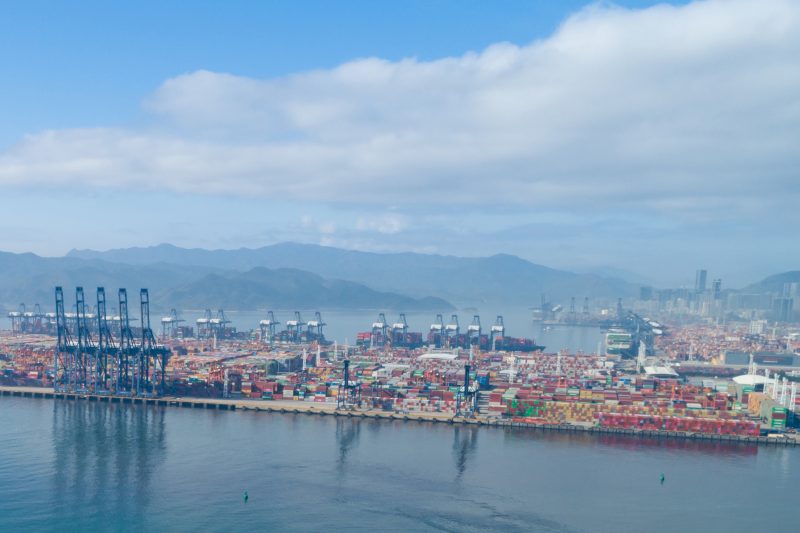In a new paper, Lorenzo Caliendo, professor of global affairs and management and an affiliate of the Yale Economic Growth Center, reviews the latest cutting-edge empirical and theoretical studies on trade between the world’s two largest economies.
What are the economic effects of trade relations between the United States and China? In a new publication, Lorenzo Caliendo, Won Park Hahn Professor of Global Affairs and Management at the Jackson School of Global Affairs and an affiliate of the Yale Economic Growth Center (EGC), and co-author Fernando Parro reviewed findings from a growing empirical and theoretical literature focused on two key periods: China’s expansion and penetration into the US market starting in the 2000s, and the US-China trade war that began in 2018.
Their review comprised their own work and a wealth of other research, finding that increased US-China trade during the first period created net welfare gains — but that these gains were unequally distributed among winners and losers across US sectors and regions. They also found that the reduction in trade caused by the trade war generated net welfare losses and did not reduce prior trade-induced inequalities.
What happens when the world’s two biggest economies are also the world’s largest trading partners?
Following decades of significant economic growth, China is now the largest supplier of goods to the world economy. China has also become one of the largest trading partners of the world’s largest economy, the United States. The jump in US imports from China — from 3.1 percent of total American imports in 1990 to 19.2 percent in 2020 — was accompanied by an increase in US exports to China, from 1.3 percent to 9.3 percent of total exports. During this period, the US economy underwent important changes; in particular, US manufacturing employment — which had been falling steadily since the 1960s — fell even more rapidly between 2000 and 2008.
This period of increased trade — referred to as the “China shock” by economists — was followed by a similarly unprecedented increase in trade protectionism during the recent US-China trade war. In 2018, the US imposed tariffs on 17.6 percent of its 2017 imports, affecting transactions equivalent to 5.5 percent of China’s GDP. For more than a decade, economists have been studying the China shock, but they have only just begun to grapple with the effects of the recent trade war.
In a paper forthcoming in the Annual Review of Economics, Caliendo — who also serves as deputy dean at the Jackson School — and Parro review findings from a growing empirical and theoretical literature focused on two key questions: What were the economic effects of the rapid growth in trade relations between the US and China, and did the 2018 trade war reverse the effects of this trade boom?
Researchers cited in this review have developed a wide set of methodologies to isolate and measure the overall effects of the China shock, as well as estimate it impact on particular sectors and groups of the US economy. By delving into the recent history of US-China trade relations, these researchers have also been able to revisit and address classic questions in the international trade literature, such as measuring the aggregate welfare effects and distributional impacts of trade.
“All these new methodologies bring a few common benefits,” Caliendo said in an EGC interview. “One is that they allow us to better understand the mechanisms behind the impacts of international trade. Another is that they allow us to look at heterogeneous effects — or how trade impacts different groups differently. And yet another is that they have allowed for a better understanding of large-scale, or aggregate, effects.”
What contributed to the “China shock”?
The China shock was driven by two important factors. First, domestic economic reforms in the 1990s and 2000s increased China’s productivity, especially in the manufacturing industry. In particular, the reallocation of labor and capital across manufacturing firms appears to have been an important source of productivity growth. Second, the US-China Relations Act of 2000 and China’s 2001 entry into the World Trade Organization loosened trade barriers between the two countries.
For both countries, this rapid expansion in trade generated overall gains, measured in real income, and translated to annual growth in income after adjusting for prices. Caliendo and Parro estimate that trade with China accounted for 17 percent of US gains from trade between 1995 and 2011, while trade with the US accounted for 10 percent of Chinese gains from trade.

However, the US gains from trade were unequally distributed across the economy, creating winners and losers. For instance, several studies link increased Chinese import competition to the acceleration of US manufacturing employment losses in the 2000s. A 2019 study by Caliendo and Parro with coauthor Maximiliano Dvorkin found that increased Chinese import competition reduced the aggregate US manufacturing employment share by 0.36 percentage points or about 550,000 jobs — many of them in the electronics, furniture, textiles, metal, and machinery industries. Another study estimated that increased exposure to imports in US manufacturing markets lowered overall manufacturing employment by 1.1 percentage points between 2000 and 2007.
Yet increased Chinese import competition does not seem to have been the primary driver behind the decline of US manufacturing employment. As noted, this trend had been occurring since the 1960s; Caliendo, Dvorkin, and Parro’s 2019 study estimated that the China shock accounted for about 16 percent of the observed decline in total US manufacturing employment during this period. Other studies estimated the China shock was accountable for shares anywhere from one third to 55 percent of the decline in total US manufacturing employment.
Furthermore, US-China trade also increased domestic US employment in other, non-manufacturing sectors (e.g., construction and services, as well as wholesale and retail) thanks to the availability of cheaper intermediate inputs from China. For instance, one study from the National Bureau of Economic Research found that the decline in manufacturing employment due to the China shock was quickly balanced out by the creation of jobs in services and agriculture.
The US-China trade war
In 2018, the boom in US-China trade relations came to a sudden halt during the trade war. The resulting decline in trade generated overall welfare losses in the US of 0.1 percent of real income per year.
While the effects on overall employment were small, US wages declined across industries. A study by Caliendo and Parro published in the Handbook of International Economics estimated that US real wages declined by 0.16 percent overall because of the trade war. Some US states felt these losses more than others, with real wage losses of less than 0.1 percent in states like Alabama, Iowa, New Hampshire, and Wisconsin, to losses of more than 0.2 percent in California, Idaho, Nevada, and New Mexico.
Evidence also suggests that the trade war did not reverse the China shock’s distributional effects on the US economy. Reduced US-China trade did not lead to a recovery in the manufacturing sector. Instead, the authors estimate that the trade war slightly decreased manufacturing employment even further, by about 0.03 percentage points. Only a handful of industries that experienced employment losses during the China shock — textiles, petroleum, plastic, and non-metallics — gained employment during the trade war.
The trade war might have negatively affected manufacturing employment due to an increase in the cost of “intermediate inputs,” or the production components and materials that domestic manufacturing firms import from abroad, according to one study.
The research Caliendo and Parro have gathered has the potential to inform policies that can mitigate further negative effects. “Research in international trade and its associated methods and models have strong potential to inform policy,” Caliendo said. “Not only does this research allow us to understand trade shocks that have already occurred, they will also allow us to analyze shocks that might arrive in the future.”
David Alzate is an intern research manager at the Yale Economic Growth Center (EGC) and an M.P.P. student at the Yale Jackson School of Global Affairs. This article originally appeared on the Economic Growth Center website.
